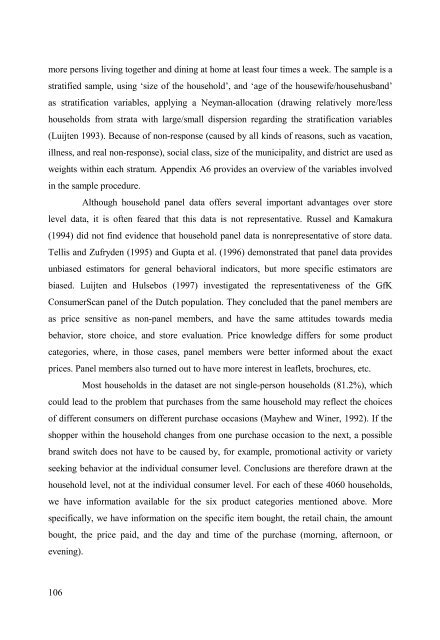Analysis of Sales Promotion Effects on Household Purchase Behavior
Analysis of Sales Promotion Effects on Household Purchase Behavior
Analysis of Sales Promotion Effects on Household Purchase Behavior
Create successful ePaper yourself
Turn your PDF publications into a flip-book with our unique Google optimized e-Paper software.
more pers<strong>on</strong>s living together and dining at home at least four times a week. The sample is a<br />
stratified sample, using ‘size <str<strong>on</strong>g>of</str<strong>on</strong>g> the household’, and ‘age <str<strong>on</strong>g>of</str<strong>on</strong>g> the housewife/househusband’<br />
as stratificati<strong>on</strong> variables, applying a Neyman-allocati<strong>on</strong> (drawing relatively more/less<br />
households from strata with large/small dispersi<strong>on</strong> regarding the stratificati<strong>on</strong> variables<br />
(Luijten 1993). Because <str<strong>on</strong>g>of</str<strong>on</strong>g> n<strong>on</strong>-resp<strong>on</strong>se (caused by all kinds <str<strong>on</strong>g>of</str<strong>on</strong>g> reas<strong>on</strong>s, such as vacati<strong>on</strong>,<br />
illness, and real n<strong>on</strong>-resp<strong>on</strong>se), social class, size <str<strong>on</strong>g>of</str<strong>on</strong>g> the municipality, and district are used as<br />
weights within each stratum. Appendix A6 provides an overview <str<strong>on</strong>g>of</str<strong>on</strong>g> the variables involved<br />
in the sample procedure.<br />
Although household panel data <str<strong>on</strong>g>of</str<strong>on</strong>g>fers several important advantages over store<br />
level data, it is <str<strong>on</strong>g>of</str<strong>on</strong>g>ten feared that this data is not representative. Russel and Kamakura<br />
(1994) did not find evidence that household panel data is n<strong>on</strong>representative <str<strong>on</strong>g>of</str<strong>on</strong>g> store data.<br />
Tellis and Zufryden (1995) and Gupta et al. (1996) dem<strong>on</strong>strated that panel data provides<br />
unbiased estimators for general behavioral indicators, but more specific estimators are<br />
biased. Luijten and Hulsebos (1997) investigated the representativeness <str<strong>on</strong>g>of</str<strong>on</strong>g> the GfK<br />
C<strong>on</strong>sumerScan panel <str<strong>on</strong>g>of</str<strong>on</strong>g> the Dutch populati<strong>on</strong>. They c<strong>on</strong>cluded that the panel members are<br />
as price sensitive as n<strong>on</strong>-panel members, and have the same attitudes towards media<br />
behavior, store choice, and store evaluati<strong>on</strong>. Price knowledge differs for some product<br />
categories, where, in those cases, panel members were better informed about the exact<br />
prices. Panel members also turned out to have more interest in leaflets, brochures, etc.<br />
Most households in the dataset are not single-pers<strong>on</strong> households (81.2%), which<br />
could lead to the problem that purchases from the same household may reflect the choices<br />
<str<strong>on</strong>g>of</str<strong>on</strong>g> different c<strong>on</strong>sumers <strong>on</strong> different purchase occasi<strong>on</strong>s (Mayhew and Winer, 1992). If the<br />
shopper within the household changes from <strong>on</strong>e purchase occasi<strong>on</strong> to the next, a possible<br />
brand switch does not have to be caused by, for example, promoti<strong>on</strong>al activity or variety<br />
seeking behavior at the individual c<strong>on</strong>sumer level. C<strong>on</strong>clusi<strong>on</strong>s are therefore drawn at the<br />
household level, not at the individual c<strong>on</strong>sumer level. For each <str<strong>on</strong>g>of</str<strong>on</strong>g> these 4060 households,<br />
we have informati<strong>on</strong> available for the six product categories menti<strong>on</strong>ed above. More<br />
specifically, we have informati<strong>on</strong> <strong>on</strong> the specific item bought, the retail chain, the amount<br />
bought, the price paid, and the day and time <str<strong>on</strong>g>of</str<strong>on</strong>g> the purchase (morning, afterno<strong>on</strong>, or<br />
evening).<br />
106

















